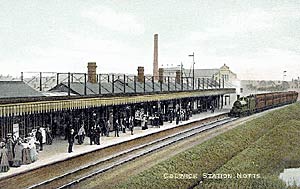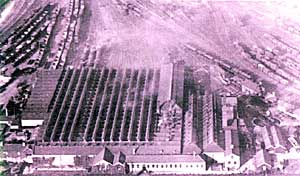< Previous | Contents | Next >
Rail and road transport

Colwick railway station, c.1901.
The Midland Railway was the first to run through Colwick, and it was opened in 1848. Laying of the line did not make much change to the village, apart from separating the Hill from the Vale side. On the original plans for the line, two tunnels were marked out, between where the Roundhouse stood and Colwick Crossings, and the road from the Hall to Park Farm was to be taken over the top of the line. This must have been revised, as the foot of the hills have been cut back and the old road is a level crossing when the line was opened.
The Ambergate, Nottingham, Boston and Eastern Junction line planned a line from Grantham to Nottingham, and by 1850, had laid rails from Grantham to Colwick, a distance of 22 miles, but could not get permission tram Parliament for the last 3 miles to Nottingham. The Midland Railway attempted an amalgamation with this line but a Great Northern shareholder acquired enough shares to vote against their proposal in the spring of 1852, and when the Great Northern came forward with a similar proposal in May, 1852, this gentleman’s influence was sufficient to ensure an acceptance and a working agreement was signed between the companies while the consent of Parliament was obtained.
The Great Northern time-table for August, 1852, advertised the commencement of a service from London to Nottingham, via Grantham, which was only possible by running on the Midland lines from Colwick Station and using the Ambergate Railway carriage and engines. When the first train on this new service ran into Midland Station, Nottingham, it was drawn by a Great Northern engine. The train was immediately surrounded by Midland engines and compounded in a shed, and the lines leading out were removed to stop the engine being taken away. The Midland authorities released the engine seven months later, after the Great Northern had produced documents in court to prove that the Ambergate Company had hired it. The Ambergate Company continued to convey the Great Northern traffic over the Midland lines until 1857, permission was then obtained to extend the Ambergate lines to Nottingham at the same time as the Great Northern were allowed to take over the Ambergate Company. A new station at London Road, Nottingham, was built for the trains from Colwick.
The first plan for this extension, shows the lines running in the same position as when the line was closed down, as far as where the main entrance to Lawrence’s factory is and then the line was to go in a wide curve down to join the existing line near to the river, with no station being indicated at Colwick. This was not passed and the line had to carry on and join up at the existing station. The line caused the line of Colwick Road to be moved between where the Roundhouse stood and the road coming up from the Hall, and also the removal of a Lodge House, which stood where the road bridge goes over the line. The two bridges, one at the station and the other at the hall were not indicated on the opening plans, so were added at a later date. Two bridges have been built at the hall crossing; the second one to take modern traffic was erected in 1930/1.

LNER sidings and depot from the air, 1930s.
Shortly after the coal traffic line from Colwick Junction to Derby was opened in August, 1875, the laying out of Colwick Sidings began. This was made up of twenty miles of sorting sidings with accompanying engine sheds etc., covering 150 acres of land in Colwick and Carlton, which was later to be called Netherfield. The sidings brought work for many of the village men and the Grantham line provided plenty of cheap transport and a fast way into town, for work and shopping. With the start of bus services in the twenties, the rail service started to decline until, in 1970, the Grantham and Lincoln lines were once again joined up at Colwick and both services running into Nottingham Midland Station. The rails of the closed section were removed in 1971. In April, 1970, Colwick sidings were closed down under the modernisation of the British Railways. Where once an army of 2,000 men, and hundreds of trains, clanked to and fro daily, were reduced to a maze of bare rails and empty buildings. The last few days of 1971, saw the demolition of the old water tower and the coaling plant, almost completing the clearance of all traces of the sidings.
Road transport
In 1887, Thomas Hobbs was running a carrier service from the New Georgs, Warser Gate, to Colwick and Netherfield, which also carried passengers. By 1899, Tippler Brothers ran a horse bus service to Carlton, Netherfield, Colwick and Gedling from the New George.
The railway had no real competition from the roads until the first World War period, when the first Bus service through Colwick was started from Burton Joyce via Netherfield and Colwick to Nottingham. This service was run by Sam and Harry Gregson, colliers from Lancashire, who used two old army vehicles with seats running along each side, from back to front, no roof and solid tyres. This service was later taken over by a Mr. Clayton, who ran a twice a day service, still using the same type of vehicle. A Mr. Cottrill was running a bus called the Royal Blue at the same time as Gregsons’. A person called Tuxford, also ran a bus through Colwick, and about 1922, the driver killed a man on the old Hall Bridge. All these services ran into the old Market Square.
Towards the end of 1922, beginning of 1923, the Trent Motor Traction Co. Ltd., started to buy out all these small services and in April, 1923, they opened their first bus service from Nottingham to Gedling via Colwick and Netherfield. In July of the same year, they began a service to Burton Joyce, and in February, 1928, one to Gunthorpe. Many of the vehicles used in that period by the company were manufactured by the Birmingham & Midland Omnibus Co. Ltd., now known as the Midland Red. Most of these buses would have had solid tyres, although they did acquire a bus with pneumatic tyres as early as 1921. Until 1924, the buses were painted green and then they were changed to the now well known red and cream. One can hardly realise now that in l944, the return fare from Bank Corner, Netherfield, to Nottingham was only 3d or 1½ new pence.
